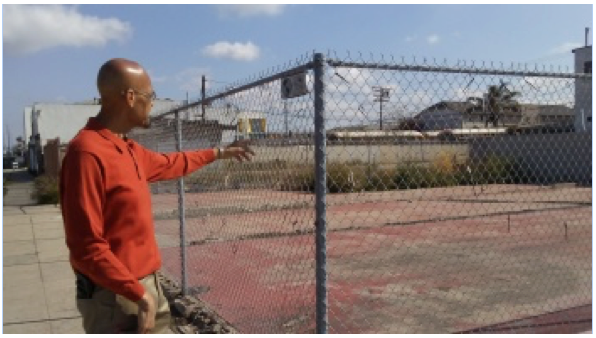CommentsURBAN PERSPECTIVE--It has become a ritual with me. On the 10th, 20th, and now 25th anniversary of the LA riots, I do a press tour of several of the same burned out empty lots in South LA. I preface the tour with a finger point at the empty lots, and ask, no challenge, with the question: “Why years after the riots are these empty lots where thriving businesses once stood still empty today?” (See photo above)
I quickly point out that in the years, no decades, since many parts of Los Angeles from the Westside to downtown have been virtually remade and billions have been poured into the construction of glitzy, pricey, showy, and functional office buildings, retail stores, boutiques, restaurants, hi-tech centers, and light industry and manufacturing enterprises.
The building bonanza has resulted in thousands of new construction and entry level and professional jobs. In the process, it’s enriched the tax coffers of the city and surrounding cities. The lame excuse that there’s no economic incentive to build in South L.A won’t fly. Residents spend millions on consumer goods and services, tens of thousands are well-to-do business and professional and trades persons, and they repeatedly clamor for quality retail, restaurant and service business in South LA. But the lots remain empty.
While speaking with the press at the burned-out lots, my mind continually goes back to those two fateful days at the end of April and the first day of May 1992, I ducked around police cordons and barricades, and cringed in fear and anxiety at the cackle of police gunfire and the non-stop roar of police fire engines and siren all around my house in South LA.
I choked, and gagged on and was blinded by the thick, acrid smoke that at times blotted out the sun and gave an eerie surreal Dante’s Hell feel to Los Angeles.
I watched many Los Angeles Police Department officers stand by virtually helpless and disoriented as looters gleefully made mad dashes into countless stores. Their arms bulged with everything from clothes to furniture.
I watched an armada of police from every district throughout California and the nation, National Guard units and federal troops drive past my house with stony, even scared looks on their faces, but their guns at ready.
I watched buildings, stores and malls that I shopped at and frequented, instantly disappear from the landscape in a wall of flames.
Several friends that lived outside LA and were concerned about my safety implored me to leave my home in the middle of the riot area and stay with them until things blew over. I thanked them but I decided to stay put. As a journalist, I felt bound to observe and report first-hand the mass orgy of death and destruction that engulfed my South Los Angeles neighborhood during the two fateful days of the most destructive riot in U.S. history.
The warning signs that LA was a powder keg were there long before the Simi Valley jury with no blacks acquitted the four LAPD cops that beat Rodney King. There was the crushingly high poverty rate in South LA, a spiraling crime and drug epidemic, neighborhoods that were among the most racially balkanized in the nation, anger over the hand slap sentence for a Korean grocer that murdered a black teenage girl, Latasha Harlins, in an altercation.
Black-Korean tensions that had reached a boiling point.
And above all, there was the bitter feeling toward an LAPD widely branded as the nation’s perennial poster police agency for brutality and racism.
This year, on the 25th anniversary of the King verdict and the LA riots, many still ask the incessant question: Can it happen again? The prophets, astrologers and psychics couldn’t answer a question like that with absolute certainty. But there are two hints that give both a “yes” and “no” answer to the question.
The yes is the repeated questionable killings of young unarmed African Americans by police, such as Michael Brown, Ezell Ford, Eric Garner, and Philando Castile, nationally and in LA County. This continues to toss the ugly glare on the always fragile, tenuous, and at times openly hostile relations between African Americans and the police. The other cause for wariness is conditions in South LA and other urban communities.
On the fortieth anniversary in 2005 of the other LA riot that ripped the nation, namely the Watts riots in 1965, the LA chapter of the National Urban League and the United Way issued an unprecedented report on the State of Black LA.
The report called the conditions in South LA dismal, stating that Blacks still had higher school drop-out rates, greater homelessness, died younger and in greater numbers, were more likely to be jailed and serve longer sentences, and were far and away more likely to be victims of racial hate crimes than any other group in LA County. The most cursory drive through the old riot areas still shows that for many residents little has changed.
The LA riots are no longer the national and world symbol of American urban racial destruction, neglect and despair. But it’s is still a cautionary tale; a warning that in the Trump era, the poverty, violence and neglect that made the LA riots symbolic may not have totally evaporated twenty-five years after the flames. And, so it will remain … as long as the lots, and what they symbolize, remain empty.
(Earl Ofari Hutchinson is an author, political analyst and a CityWatch contributor. He is the author of In Scalia’s Shadow: The Trump Supreme Court (Amazon Kindle). He is an associate editor of New America Media. He is a weekly co-host of the Al Sharpton Show on Radio One.)
-cw
Explore
Our mission is to promote and facilitate civic engagement and neighborhood empowerment, and to hold area government and its politicians accountable.

 CityWatch Los Angeles
Politics. Perspective. Participation.
CityWatch Los Angeles
Politics. Perspective. Participation.
19
Sat, Apr















